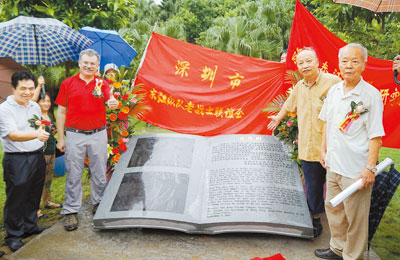
Zhang Xiaoyi
417880236@qq.com
DAVID KERR, son of Donald W. Kerr, a lieutenant of the U. S. Flying Tigers who was rescued by the East River Column during World War II, joined the unveiling ceremony of a monument at Donghu Park in Luohu District, Shenzhen, yesterday afternoon.
The monument, designed by Lin Zhiyong, the son of a soldier who was in the column, is dedicated to the memory of friendship between Chinese and U.S. veterans.
In the rain, around 30 family members of the column soldiers, as well as elderly veterans, crowded around Kerr.
The Flying Tigers helped Chinese forces during World War II (1937-1945).
Eight of them were rescued by the column, a Guangdong-based guerrilla force, after they were injured in a plane crash while fighting the Japanese in 1944.
“It feels very much like a family. Just like my father felt the East River Column is another family to him, because they saved him and gave him a new life,” said Kerr.
The family members present yesterday were mostly second generation of the soldiers. Half of them are now rooted in Shenzhen, with the other half coming from Guangzhou. Thanks to the deep relations between their parents, they started the East River Column Research Association five years ago.
“Our parents had no worries for living and eating. And they actually donated money to fight the war,” said Jia Hai’an, vice director of the association in Shenzhen whose father served as a column soldier. Jia’s father was also the first mayor of Shenzhen, Jia Hua.
Zeng Xiaofen, who is the daughter of one of the soldiers, confirmed it. Zeng said her father, educated in Kuala Lumpur, Malaysia, was sent there to escape the war by her grandfather.
“But he bought a ferry ticket and came back to fight the war,” said Zeng.
Also present at the ceremony was a 92-year-old veteran, Zeng Fa. Zeng delivered a speech, giving a detailed description of the war.
He will attend the V-day parade in Bejing on Thursday.
Kerr said he found his father’s war journal back in the 1980s, but had no contacts with the veterans. It was not until 2008 when he visited the museum at Dongjiang Memorial Hall in Pingshan New Area in Shenzhen that he was put into contact with them. Since then they have built a bond.
“We visit old soldiers. They introduced me to some who have met my father, and also many old soldiers who have not met my father but helped him escape using diversionary tactics or guarding him,” said David.
He even went to the Pingshan cemetery to visit the tombs of Jiang Shan’s parents. Jiang’s mother was at the frontline of assistance for Kerr’s father.
Kerr visited the site in 2008 when they planted two trees beside where now the monument stands. “I’m glad to see how the trees are. They were much smaller then,” said Kerr.
“I met the second generation, third generation, and sometimes the fourth generation,” said Kerr.
|

